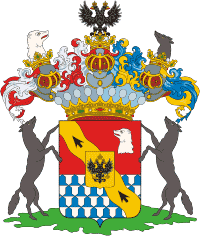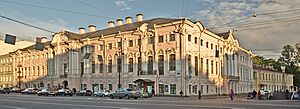Stroganov family facts for kids
Quick facts for kids StroganovСтро́гановы
|
|
|---|---|
| Merchants, nobility | |

Arms of Counts Stroganov
|
|

Anikey Stroganov, progenitor of the ennobled branch
|
|
| Current region | Muscovy, Russian Empire |
| Place of origin | Disputed: Tatar, Veliky Novgorod, Pomor |
| Founded | 15th century |
| Founder | Spiridon Stroganov; Fyodor Lukich Stroganov (the Solvychegodsk branch). |
| Current head | Noble branch is extinct; the family continues in its non-noble senior line. |
| Distinctions | One of the richest Russian families in history Stroganov School of icon painting |
The House of Stroganov was a very successful Russian family. They were known as rich merchants, factory owners, landowners, and important government officials. From the time of Ivan the Terrible (who ruled from 1533 to 1584), they were the wealthiest business people in Russia.
They helped pay for the Russian conquest of Siberia starting in 1580. They also supported Prince Pozharsky in 1612 to take back Moscow from the Poles. The famous Stroganov School of icon painting is named after them. The family's earliest known ancestor was Fyodor Lukich Stroganov, a salt producer who died in 1497. His older son, Vladimir, started a family line that later became state peasants. This line still exists today. The line from Fyodor Lukich Stroganov's youngest son, Anikey Stroganov (1488–1570), ended in 1923. Anikey's descendants became part of Russia's high nobility under the first Romanov tsars.
Contents
Who Were the Stroganovs?
People have different ideas about where the Stroganov family came from. Some thought they were merchants from Veliky Novgorod. But a historian named Andrey Vvedensky found that they likely came from wealthy Pomors. These were Russian peasants from the subarctic north, near the White Sea.
The family's first known ancestor was Spiridon. He lived around the 1390s. His grandson, Luka Kuzmich Stroganov, rented royal lands near the Northern Dvina river. It is said he helped free Duke Vasily II of Moscow from Tatar capture in 1445.
The Family's Early Business Ventures
Luka's son, Fyodor Lukich Stroganov (died 1497), moved to Solvychegodsk in northern Russia. He was a local salt producer and owned properties. He passed these down to his oldest son, Vladimir. Fyodor had six sons and one daughter.
In 1517, Fyodor's older sons, Stefan, Joseph, and Vladimir, received a wood and salt mine in the Ustyug area. Vladimir Stroganov's family line continues today. However, his descendants later became state peasants, meaning they worked for the government.
Anikey Fyodorovich Stroganov (1488–1570) was Fyodor's youngest son. He started the noble line of the Stroganov family, which is now extinct. In 1515, he opened saltworks that grew into a huge business. In 1558, Ivan the Terrible gave Anikey and his family large land areas. These lands were on the eastern edge of Russian settlements, along the Kama and Chusovaya Rivers.
Expanding Their Influence and Power
In 1566, the Stroganovs asked for their lands to be part of the "oprichnina." This was a special territory directly controlled by Ivan the Terrible. The Stroganovs took lands from local people and brought in Russian peasants to settle them. They developed farming, hunting, salt production, fishing, and mining in these areas.
They built towns and strong forts. They also put down local rebellions using their own small private army. This way, they added new lands in the Urals and Siberia to Russia.
Yakov Anikeevich Stroganov (1528–1577) convinced Ivan the Terrible to stop English traders near Solvychegodsk. He and his brothers were allowed to attack Siberian tribes and rulers. He also provided the tsar with luxury goods, like sable fur. In 1574, he and his brother Grigory received large lands in Siberia along the Ob River.
Grigory Anikeevich Stroganov (1533–1577) received large lands in the Kama river basin near Perm. In 1558, he was allowed to produce saltpetre. In 1564, he was given permission to build a town called Kargedan, later known as Oryol-gorodok.
Semyon Anikeyevich Stroganov (died 1609) and Anikey's grandsons Maksim Yakovlevich Stroganov (died 1620s) and Nikita Grigoriyevich Stroganov (died 1620) helped start and pay for Yermak's journey into Siberia in 1581.
By the late 1500s, the Stroganovs owned huge amounts of land and were major salt producers. In the early 1600s, during a time of trouble in Russia, they became even stronger. They supported the government against those who wanted to take the throne and against Polish invaders. The family slowly started to join the nobility.
Becoming Part of the Nobility
In 1608, Kozma Danilovich Stroganov (1580–1617) was a military governor in Totma. He died without children.
During the Polish invasion in the early 1600s, the Stroganovs gave a lot of money and military help to the Russian government. They gave about 842,000 rubles in money alone. Because of this, they received the title of "eminent men" in 1610. They were also allowed to add 'vich' to their father's names, which was usually only for members of the royal court.
With this new title, they got special rights that traders usually did not have. They were only judged by the king, could build towns and forts, own armed troops, make cannons, organize military campaigns against Siberian rulers, and trade with Asian nations without paying taxes.
In the 1600s, the Stroganovs began to marry into high Russian noble families. For example, Pyotr Semyonovich Stroganov (1583–1639) married Matryona Ivanovna Borbischeva-Pushkina. Maksim Maksimovich Stroganov (1603–1627) married Anna Alferyevna Streshneva, who was a cousin of Tsarina Eudoxia Streshneva. The Stroganovs married daughters of military governors and courtiers. They married into princely families like the Volkonskys and Golitzines.
In the 1600s, the Stroganovs invested a lot in the salt industry in Solikamsk. In the 1680s, Grigory Dmitriyevich Stroganov (1656–1715) brought together all the lands owned by the different heirs of Anikey Stroganov's children. He also took over the saltworks that belonged to the Shustov and Filatiyev families. In the 1700s, the Stroganovs built many ironworks and copper factories in the Urals mountains.
The Stroganov family also built many beautiful Baroque churches across Russia in the late 1600s and early 1700s. These include the Cathedral of the Presentation of Mary in Solvychegodsk (1688–1696) and the Church of the Synaxis of the Mother of God in Nizhny Novgorod (started in 1697).

The Older Stroganov Family Line
The descendants of Vladimir Fyodorovich Stroganov, one of Fyodor Lukich Stroganov's older sons, became poor by the 1700s. They became state peasants. Vladimir inherited his father's properties in Solvychegodsk. He later bought the village of Tsyrennikovo, north of Solvychegodsk. This village became the home for this part of the family for many generations.
Afanasy Vladimirovich Stroganov (died 1607) worked in the local salt and fur trade. With his earnings, he bought land around his village. Afanasy received the title of gost (an important merchant). He also rented a royal estate near Solvychegorsk. Afanasy Vladimirovich was still seen as a relative by Anika's wealthy family. But his son, Ivan, was the first in this family line to face a continuous decline in money and social standing.
By the 1670s, the rich descendants of Anika Stroganov and the poor older branch of the family had grown apart. The wealthy part of the family denied their connection to the poor one. This might be why a myth started that Anika's older brothers supposedly died without children.
By the late 1600s, the poor Stroganovs lived almost like common peasants. Because they were so poor, this branch started doing manual labor and even robbery. One member, Andrey Vasilyev syn Stroganov, was among the first Russians in Siberia in the 1600s. He built forts in the Zabaykaliya region. He later became a leader of a Cossack group.
A historian named A. Vvedensky found that when the poor relatives visited the wealthy family's palace in Saint Petersburg, the servants were told to kick them out.
In 1911, Count Pavel Sergeevich Stroganov died without children. His fortune of 120 million rubles was supposed to go to the state. A famous lawyer named Maklakov started research to prove a connection between the late count and the Stroganovs from Tsyrennikovo. Maklakov won the case against the count's relatives on his mother's side. Maklakov settled in Tsyrennikovo, wanting to share the inheritance with the poor Stroganov relatives. However, the inheritance got stuck in legal paperwork. Then the Russian Revolution happened, which stopped the poor Stroganov branch from getting their inheritance.
The Stroganov Noble Line
The titled branch of the Stroganov family came from Anikey Stroganov, the youngest son of Fyodor Lukich Stroganov (died 1497). From the 1600s, Anika's descendants were very close to the royal court. They mixed with the highest nobility and even married into some noble families. During this time, they started to distance themselves from their poor, almost peasant, relatives from the older line. They even completely denied being related.
One descendant, Grigory Dmitrievich Stroganov (1656–1715), supported Peter the Great. He was often invited to the court of Tsar Alexey Romanov, even to his private dinners. He gave four military ships he built to Peter the Great. Grigory's sons were given the title of baron by Peter the Great in 1722.
During the Great Northern War (1700–1721), the Stroganovs gave a lot of money to Peter the Great's government. Because of this, Alexander Grigoriyevich, Nikolay Grigoriyevich, and Sergei Grigoriyevich were made barons in 1722 and later counts.
From then on, the Stroganovs were part of the Russian aristocracy and held important government jobs.
- Sergei Grigoryevich Stroganov (1707–1756) was important during the rule of Elizabeth Petrovna.
- His son Alexander Sergeyevich (1733–1811) helped create new laws for Catherine the Great. He also held positions like president of the Russian Academy of Arts.
- Pavel Alexandrovich Stroganov (1772–1817) was a member of a special committee for Alexander I.
- Sergei Grigoryevich Stroganov (1794–1882) was the governor general of Moscow from 1859–1860. He also started the Stroganov Moscow Arts and Industrial Institute in 1825.
- Alexander Grigoriyevich Stroganov (1795–1891) was the minister of the interior from 1839–1841.
Many Stroganovs were interested in art, literature, history, and archaeology. They had large libraries and collections of paintings, coins, and medals. The Stroganov Palace in Saint Petersburg is a famous landmark.
In 1911, Count Pavel Sergeyevich Stroganov died without children. His death led to a legal fight over his fortune between his relatives on his mother's side and the older, non-noble descendants of the Stroganov family.
Modern Times for the Stroganov Family

After the Russian Revolution of 1917, the Stroganov family left Russia. All their property in Russia was taken by the government.
The Stroganov Foundation was started in 1992 in New York City. It is a non-profit group that works to protect and restore the Russian heritage of the Stroganov family.
Baroness Hélène de Ludinghausen, who lives in Paris, inspired the creation of the Stroganov Foundation. Her mother, Princess Xenia Alexandrovna Shcherbatova-Stroganova, was born in the Stroganov Palace.
The family line from the youngest brother, Anikey Stroganov (the noble branch), ended in 1923 because there were no more male descendants. However, the peasant line from the elder brother Vladimir Stroganov continues to this day.
Images for kids
-
Portrait of Pavel Alexandrovich Stroganov by Élisabeth Vigée Le Brun (1790's)
-
Portrait of Alexander Stroganov by Ivan Kramskoy (1882)
See also
- Beef Stroganoff is a dish named after the family
- Stroganov School of icon painting
- Demidov family
 In Spanish: Stróganov para niños
In Spanish: Stróganov para niños









